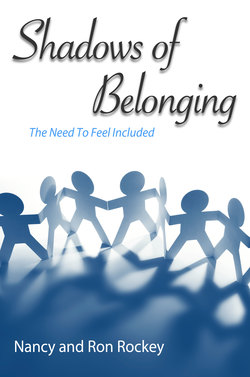Shadows of Belonging

Реклама. ООО «ЛитРес», ИНН: 7719571260.
Оглавление
Ron Rockey. Shadows of Belonging
Preface
Introduction
Chapter One. In the beginning . .
Bonding
Chapter Two. Self-Survival
Addictions
View of Self
Numbing Agents
Addiction’s Origins. Addictions are our attempts to comfort, control, numb or black out the hurt and pain of the wound received. Sadly enough, many have the addictions and no clue as to why they have them. Guaranteed, once one has found temporary relief from painful emotions, it is easy to become hooked on the relief and, in many cases, agents used for relief are themselves addictive, thus drawing the wounded to them
Influence of Parent’s Character. There are very few people who ask as soon as they find out that they are about to become parents, “What will I have to do to mess up this child?” and then proceed during pregnancy and after birth to endeavor to impact their child as negatively as they can. The desire to procreate is given to every man and the desire to bear a child is awarded to women, unless their own childhood experiences have tainted them. However, all too often, a parent’s character traits can influence a child’s development in an unhealthy way
Chapter Three. Bonding
A Sad, True Story
The Bonding Experience
A Successful Experiment
Chapter Four. Newborns Need . .
Eye-to-Eye Gazing:
Cuddling:
Your relationship with each other:
Both Mother and Father present, physically and emotionally:
Babies showing their love for you:
Babies need to feel accepted:
Babies need encouragement!
Support:
Trust is built in the first 18 months of life!
Babies, and all of us, need knowledge:
Safe and nurturing touch:
Training for self-government or decision-making:
Kids need you to participate with them:
A sense of security gives them a strong platform for growth:
Wings (at the appropriate age):
Chapter Five. Attachment
Babies Attach
Desperately Needed
Developing our own style -
Detachment
Results of Separation
Chapter Six. The Protected Self
The Avoidant:
An Avoidant Struggles With:
The Avoidant in Marriage:
Parents with Avoidant Attachment Style
The Avoidant in Relationship with God:
Hope and Healing?
Chapter Seven. The Fragile Self
How Children Become Ambivalent
They struggle with:
The Ambivalent in Marriage:
The Ambivalent parent:
The Ambivalent in relationship with God:
Hope and Healing?
Chapter Eight. The Shattered Self
Origin of Disorganized Style:
Feelings:
Their Beginnings:
Healing and Hope?
Chapter Nine. Detachment and Fear
Fear is paralytic –
Some of the things that fear does to the body:
Chapter Ten. Secure
How Children Develop a Secure Attachment:
The Blessings of the Securely Attached:
In addition, the Securely Attached:
Are large numbers of securely attached individuals in today’s society?
Chapter Eleven. I want to belong!
Examples
Steps to a Secure Attachment:
Chapter Twelve. Finally Secure
Science Helps Us
Changing Perspective
If you are or choose to be a Christian:
Back Cover
Отрывок из книги
The previous book in this series used a famous quote by a well-known British author, and here again, we would like to quote C. S. Lewis.
“We live in the Shadowlands. The sun is always shining
.....
Add to this, the birthing experience of the baby. The French obstetrician Frederick Leboyer, author of the book Birth Without Violence, argues for gentler birthing methods, and his works have instigated similar methods around the world. Science tells us that traumatic births, with lengthy labors, fetal distress, the use of forceps or suction cups to aid delivery, and even the attitude of the physician who delivers the child, all have an influence on the amount of distress experienced by the baby.
According to Dr. Verny, it is important that the child benefits by a warm, humane and reassuring environment after birth because he is aware of how he is born. The unborn child’s mind is conscious and aware, but not as deeply complex as an adult’s. He is not capable of understanding the shades of meaning that an adult can put into a simple word or gesture but is sensitive to remarkably subtle emotional nuances. He can react to such uncomplicated emotions as love and hate, and also to more “shaded complex feeling states like ambivalence and ambiguity.” The Secret Life of the Unborn Child, pages 18 and 19.
.....